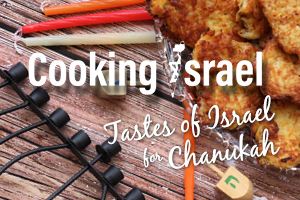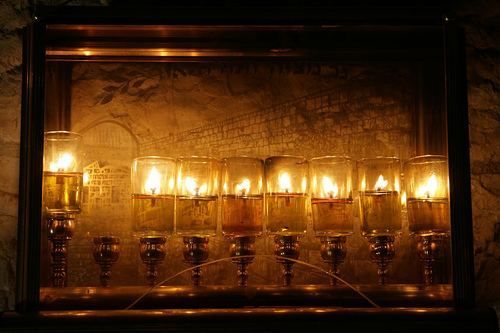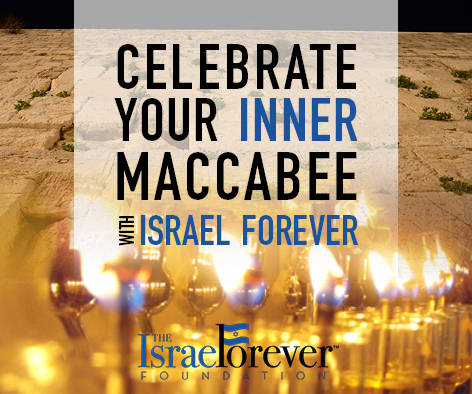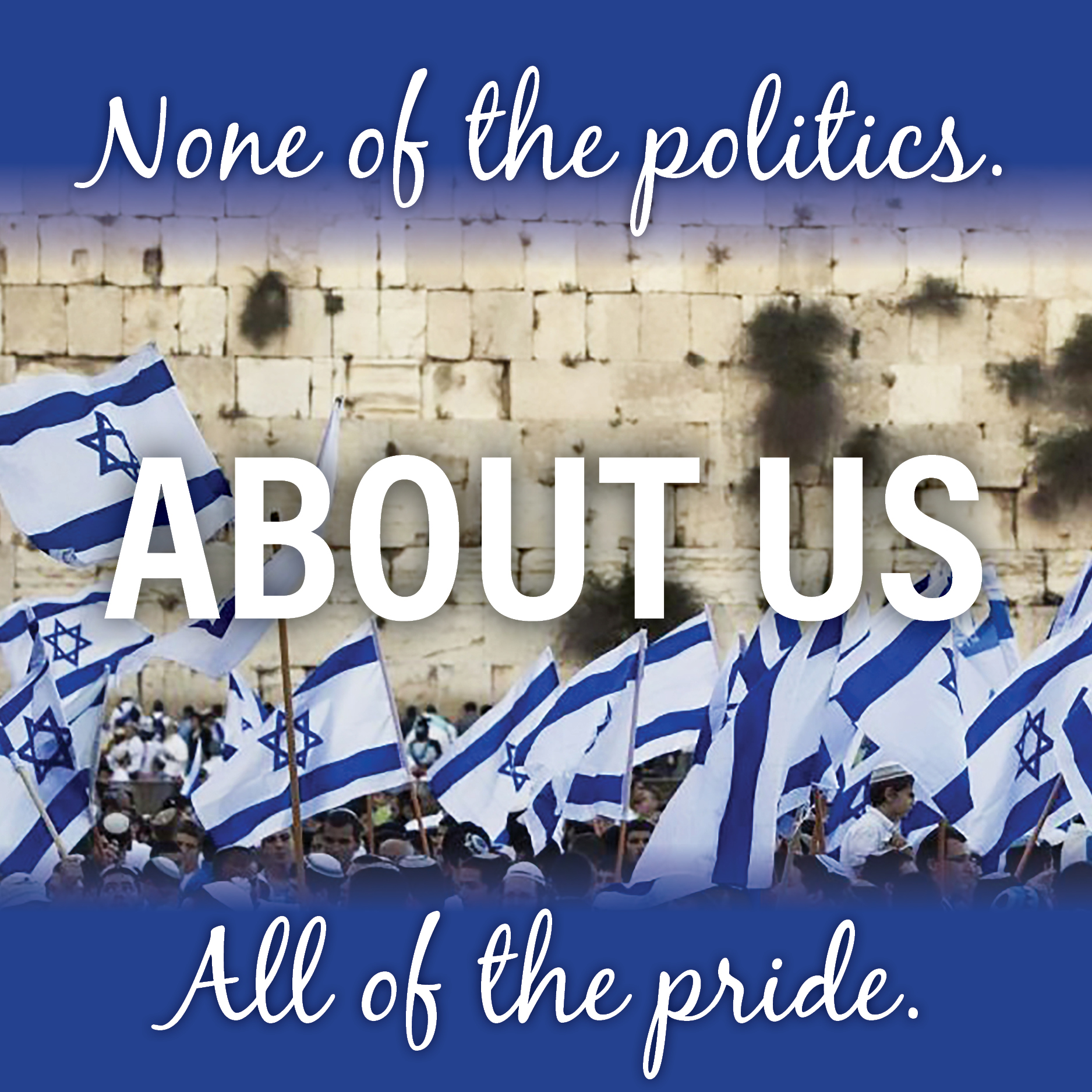Chanukah 101
By Sean Young
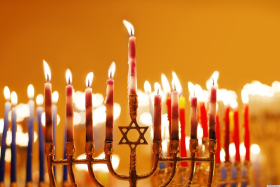
חֲנֻכָּה, the Jewish festival of rededication, also known as the festival of lights, is an eight day festival beginning on the 25th day of the Jewish month of Kislev.
Important Vocabulary:
חֲנֻכָּה – Hanukkah/Chanukah
חֲנֻכִּיָּה – Hanukkah Menorah
סְבִיבוֹן – Dreidel
לְבִיבוֹת – Latkes (potato pancakes)
כִּסְלֵו – Kislev (9th month)
שַׁמָשׁ – Shamash candle
יְרוּשָׁלַיִם – Jerusalem
חֲנֻכָּה is probably one of the best known Jewish holidays because of its proximity to Christmas. Many non-Jews and assimilated Jews think of this holiday as the Jewish version of Christmas and use some Christmas customs, such as gift-giving and decorating. In reality, this holiday is in remembrance of a revolution against assimilation and the suppression of Jewish religion. The story is related in the book of Maccabees, which Jews do not accept as scripture.
Blessings
The only religious observance related to the holiday is the lighting of candles. The candles are placed in a menorah that holds nine candles: one for each night, plus a שַׁמָשׁ at a different height. On the first night, one candle is placed at the far right. The שַׁמָשׁ is lit and three berakhot (blessings) are recited:
- A general prayer over candles:
.ברוך אתה ה’ א‑לוהינו מלך העולם, אשר קדשנו במצותיו וצונו להדליק נר של חנוכה - A prayer thanking God for performing miracles for the Jewish people at this time:
ברוך אתה ה’ א‑לוהינו מלך העולם, שעשה נסים לאבותינו בימים ההם בזמן הזה. - A general prayer thanking God for allowing us to reach this time of year:
ברוך אתה ה’ א‑לוהינו מלך העולם, שהחינו וקימנו והגענו לזמן הזה.
All three blessings are recited on the first night of חֲנֻכָּה. On all the other nights, they recite only the first two. The blessings are said before or after the candles are lit (depending on tradition).
Lighting The Candles
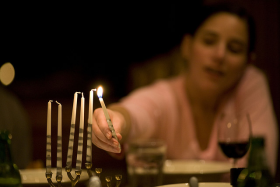
After reciting the blessings, the first candle is then lit using the שַׁמָשׁ, which is placed back in its holder. Candles can be lit any time after dark but before midnight. The candles are normally allowed to burn out on their own after a minimum of a half hour, but if necessary they can be blown out at any time after that half hour.
On Shabbat, the חֲנֻכָּה candles are normally lit before the Shabbat candles, but may be lit any time before candle lighting time (18 minutes before sunset). Candles cannot be blown out on Shabbat. Because the חֲנֻכָּה candles must remain burning until a minimum of a half hour after dark, some חֲנֻכָּה candles won’t get the job done. On one of the earlier nights, you might want to make sure your candles last long enough. If they don’t, you might want to use something else for חֲנֻכָּה on Shabbat, such as tea lights or even Shabbat candles.
Each night, another candle is added from right to left. Candles are lit from left to right, paying honor to the newer candle first. On the eighth night, all nine candles (the 8 חֲנֻכָּה candles and the שַׁמָשׁ) are lit. On nights after the first, only the first two blessings are recited; the third blessing is only recited on the first night of holidays.
Why is there a שַׁמָשׁ? The חֲנֻכָּה candles are for pleasure only; they are not used for any other purpose. The שַׁמָשׁ is kept if we need to do something requiring a candle. The שַׁמָשׁ is at a different height so that it is easily identified.
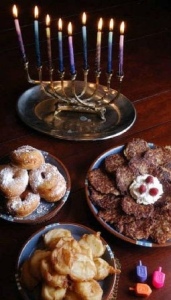
Are You Hungry On חֲנֻכָּה?
It is traditional to eat fried foods on חֲנֻכָּה because of the significance of oil to the holiday. Among Ashkenazic Jews, this usually includes latkes and nice, fat jelly donuts.
Click here for some Taste of Israel recipes!
Gift Giving
Gift-giving is not a traditional part of the holiday, but has been added in places where Jews have a lot of contact with Christians, as a way of dealing with jealousy of Christian friends. It is extremely unusual for Jews to give חֲנֻכָּה gifts to anyone other than their own young children. The only traditional gift of the holiday is “gelt,” small amounts of money.
Spinning The סְבִיבוֹן
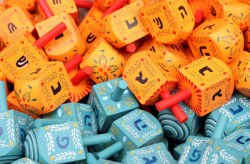
The dreidel, or סְבִיבוֹן in Hebrew, is a four-sided spinning top that children play with on Hanukkah. Each side is imprinted with a Hebrew letter. These letters are an acronym for the Hebrew words נס גדול היה שם (Nes Gadol Haya Sham, “A great miracle happened there”), referring to the miracle of the oil that took place in the Beit Hamikdash.
The letters also stand for the Yiddish words nit (nothing), gantz (all), halb (half) and shtell (put), which are the rules of the game! There are some variations in the way people play the game. The way it’s traditionally played, everyone starts by putting one coin or candy in the pot (pennies, M&Ms or chocolate coins are the popular choices). A person spins the סְבִיבוֹן and what happens when it stops spinning and the letter facing up tells you what to do:
ג (Gimel) – Take All
ה (Hey) – Take Half
ש/פ (Peh - Israel; Shin - Diaspora) – Add 1 to the pot
Do you have special traditions during Chanukah?
Share them with us - media@israelforever.org!
Share them with us - media@israelforever.org!

